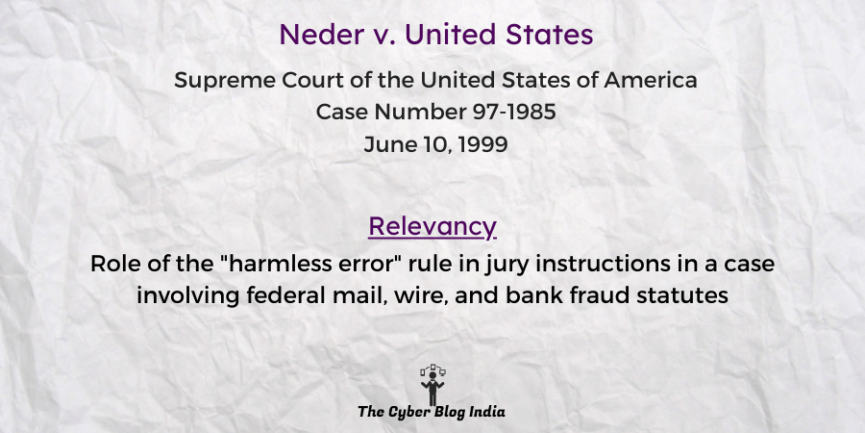Neder v. United States

Neder v. United States
527 U.S. 1, 40 (1999)
In the Supreme Court of the United States of America
Case Number 97-1985
Before Chief Justice Rehnquist, Justice O’Connor, Justice Kennedy, Justice Thomas, Justice Breyer, Justice Stevens, and Justice Scalia
Decided on June 10, 1999
Relevancy of the Case: Role of the “harmless error” rule in jury instructions in a case involving federal mail, wire, and bank fraud statutes
Statutes and Provisions Involved
- The Federal Rules of Criminal Procedure (Rule 52(a))
- Wire Fraud Statue, 18 U.S.C. §§ 1341, 1343, 1344
Relevant Facts of the Case
- The petitioner, an attorney and real estate developer, participated in a series of real estate deals. Bank-based loans had funded these deals; however, they were fraudulently obtained.
- He used shell corporations created by his lawyers to buy 12 different pieces of land. Then, he quickly resold them to limited partnerships under his control for significantly more money.
- He deceived lenders about his ownership of the shell companies. He also hid the facts that he paid much less for the land than its inflated resale value, and the limited partnerships did not put down as much money as they had claimed. He obtained loans totalling 70-75% of the inflated resale price of the land.
- Further, he signed affidavits falsely claiming he had no connection with the shell corporations. He was not profiting from the inflated land sales.
- Since loan profits surpassed the original purchase price, he obtained more than $7 million.
- He neglected to record nearly all this money on his income tax returns. He finally defaulted on the debts. He also took part in several fraud operations involving land development.
- The trial court found him guilty of filing false federal income tax returns and federal mail, wire, and bank fraud.
- At trial, the District Court ruled that the materiality of the tax and bank fraud counts was not a consideration for the jury. The evidence had already shown these aspects. Moreover, materiality was not included as an element of either the mail or wire fraud accusations by the court. The petitioner has appealed his conviction based on the lack of materiality.
Prominent Arguments by the Counsels
The petitioner’s counsel:
- In this case, the applicability of harmless mistake is precluded by alternative reasoning since the trial court in Sullivan v. Louisiana gave the jury a flawed reasonable doubt instruction. The foundation for harmless review is simply missing.
- The counsel relied on multiple precedents to argue that a jury can only reach a finding of harmless mistake if its decision depends on the instructions given by the judge to consider.
The Government’s counsel:
- The lack of a complete verdict on every element of the offence demonstrates nothing more than an incorrect instruction on an element of the offence. This violates the Sixth Amendment’s right to a jury trial.
- The term “defraud” will only have the common law meaning if the fraud legislation indicated that Congress codified the crime of false pretences or one of the common law torts sounding in fraud.
- There is no reason to believe that Congress intended to confine criminal responsibility to conduct that would constitute fraud at common law, specifically substantial misrepresentations or omissions.
Opinion of the Bench
- The harmless error rule of Chapman v. California, 386 U.S. 18, applies to a jury instruction that omits an element of an offence.
- Materiality is an element of a scheme or artifice to defraud under the federal mail, wire, and bank fraud statutes.
- The District Court’s failure to submit the tax offence’s materiality element to the jury was a harmless error.
Final Decision
- The District Court erred in refusing to submit the issue of materiality to the jury concerning those charges involving tax fraud.
- The Supreme Court remanded the case back to the Court of Appeals for deciding whether the jury instruction error was, in fact, harmless.
Parul Anand, an undergraduate student at the National Law University, Jodhpur, prepared this case summary during her internship with The Cyber Blog India in May/June 2022.
